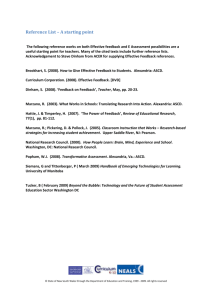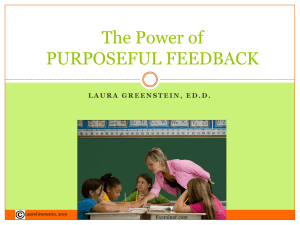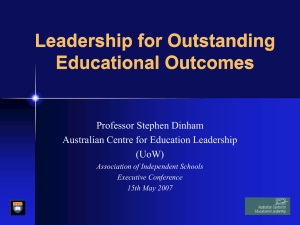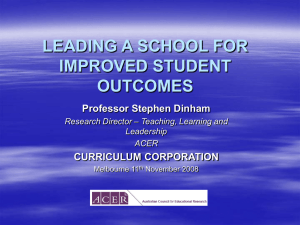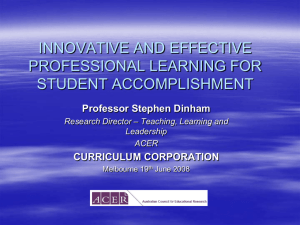Seeking and providing feedback (DOCX, 302 kB )
advertisement
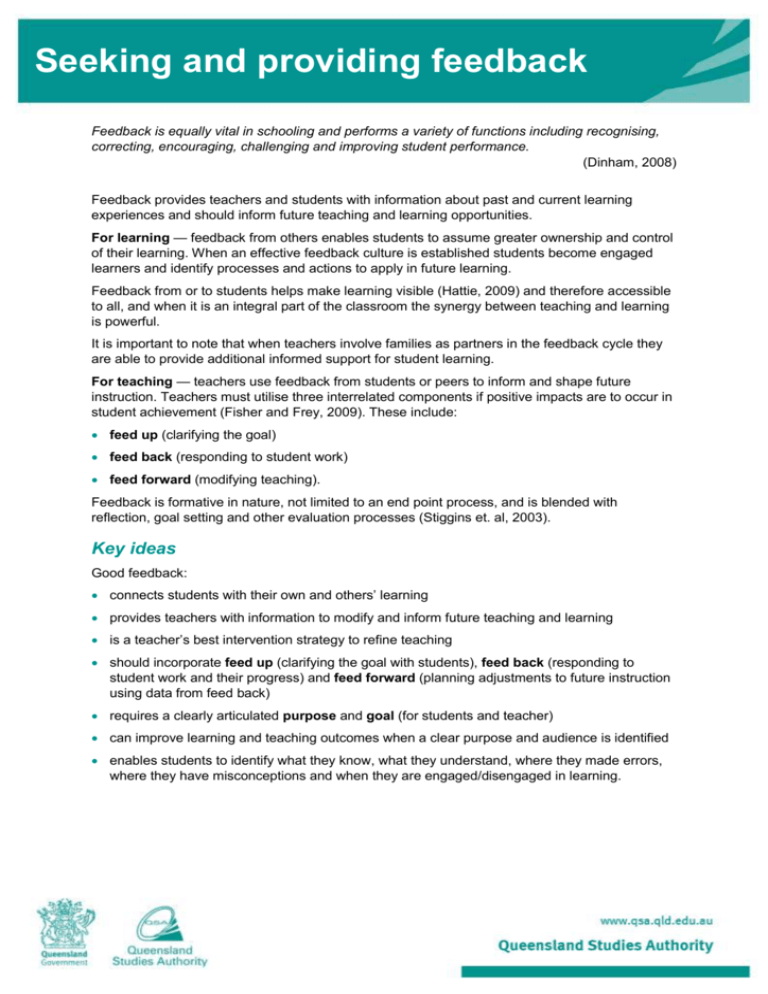
Seeking and providing feedback Feedback is equally vital in schooling and performs a variety of functions including recognising, correcting, encouraging, challenging and improving student performance. (Dinham, 2008) Feedback provides teachers and students with information about past and current learning experiences and should inform future teaching and learning opportunities. For learning — feedback from others enables students to assume greater ownership and control of their learning. When an effective feedback culture is established students become engaged learners and identify processes and actions to apply in future learning. Feedback from or to students helps make learning visible (Hattie, 2009) and therefore accessible to all, and when it is an integral part of the classroom the synergy between teaching and learning is powerful. It is important to note that when teachers involve families as partners in the feedback cycle they are able to provide additional informed support for student learning. For teaching — teachers use feedback from students or peers to inform and shape future instruction. Teachers must utilise three interrelated components if positive impacts are to occur in student achievement (Fisher and Frey, 2009). These include: feed up (clarifying the goal) feed back (responding to student work) feed forward (modifying teaching). Feedback is formative in nature, not limited to an end point process, and is blended with reflection, goal setting and other evaluation processes (Stiggins et. al, 2003). Key ideas Good feedback: connects students with their own and others’ learning provides teachers with information to modify and inform future teaching and learning is a teacher’s best intervention strategy to refine teaching should incorporate feed up (clarifying the goal with students), feed back (responding to student work and their progress) and feed forward (planning adjustments to future instruction using data from feed back) requires a clearly articulated purpose and goal (for students and teacher) can improve learning and teaching outcomes when a clear purpose and audience is identified enables students to identify what they know, what they understand, where they made errors, where they have misconceptions and when they are engaged/disengaged in learning. What are the types of feedback? Research by Michigan State University (2008) linked theories of learning to feedback types. In the table below learning theories are matched to a type of feedback and an associated positive example. Teachers can use a variety of these feedback practices in the classroom. Theories of learning Feedback Example Behaviourist Reinforce positive and negative aspects “You did a great job with your proof reading …” Socialist Observe consequences “If you continue to write in this way your results will improve …” Cognitive Check if knowledge is received, check for schema revisions “In this report you need to be sure to make clear links to support your facts and opinions …” Constructivist Check what knowledge is constructed “In your recent narrative you were successful in engaging …” Collaborative Compare notes with other learners “We both agree the only area that may need adjusting is …” Adapted from Michigan State University, 2008, Learning Elements: Feedback. What are the different levels of feedback? Dinham (2008) identified four questions students seek from feedback: What can I do? What can’t I do? How does my work compare with my earlier work? How can I do better? These types of feedback can be aligned to the four levels of feedback outlined below. Powerful feedback occurs when the learner understands the gap between their current level of performance and that of the desired performance. In the table below four levels of feedback are outlined. Each level increases in metacognitive demand and represents steps a learner may progress through when acting upon feedback. Four levels of feedback Task Gives students information on their level of performance on an assessment task. Helps to correct incorrect interpretations or responses. Processing Encourages students to use assorted strategies to self-correct. Self-regulation Guides students to move from dependency on feedback from others (external) towards developing internal feedback (self-monitoring). Self Aims to improve students’ own investment in effort or attitude. Typically motivational in nature. Adapted from Hattie, J & Timperley, H 2007, The power of feedback. 2 | Seeking and providing feedback What does effective feedback practice look like? Effective feedback focuses on the strengths of students’ achievement and on the areas in need of improvement. Assessment feedback is more helpful if learning targets (knowledge, skills and understandings) are identified, and specific suggestions for improvement are provided. For example, instead of providing student feedback such as: “C — Sound achievement”, provide focused feedback such as: “I liked the way you clearly answered each question. You could have strengthened responses 2, 8 and 9 by including a supporting fact like you did with your other responses (C — Sound achievement)”. Teachers can: use descriptive language to help students assess their progress and to understand how to achieve learning and assessment expectations involve students with opportunities to ask follow-up questions, share their learning observations or experiences, compare opinions, and relate their learning to their lives both in and outside of school focus on progress — emphasise the student’s continuous progress relative to their previous achievement and to the learning expectations — It does not compare students with their classmates ensure feedback is credible, honest and helpful in meaningful, timely and regular ways make feedback personal and avoid excessive public feedback as it can create a competitive or ego-oriented classroom environment provide feedback in a number of ways (including verbal and written feedback) describe and reflect attributes about academic performance — not attributes of students as learners develop professional relationships to collaboratively refine and inform future curriculum, instructional and strategic approaches make the learning process visible and transparent. © Queensland Studies Authority. Queensland Studies Authority | 3 Auditing my feedback practice Questions to consider when reflecting on the use of feedback in your classroom. For your student 1. a. What feedback processes do you actively use in your classroom? b. How do you use student feedback to shape future teaching and learning? How do your students use feedback for goal setting? 2. What feedback opportunities do I currently use with students? Student-led conferencing (student/teacher/parent) Portfolio sharing Informal conferencing Weekly reflection sheets Culminating activities/showcases Peer editor roles Guide to making judgments For yourself 3. What feedback opportunities do you use in your professional practice? Teaching and learning modification to units or key assessment items Guide to making judgments Collaborative unit and assessment planning Peer observation Reciprocal teaching Going further 4. a. What do I do now to improve my practice? b. 4 | What actions would I now take to enhance the use of feedback as part of practice? Seeking and providing feedback References Brookhart, S 2010 (second edn), Formative Assessment Strategies for Every Classroom (Action tool), ASCD, Virginia, USA. Clarke, S 2008, Active Learning through Formative Assessment, Hodder Education, Hachette, UK. Dinham, S 2008, “Feedback on feedback”, Teacher, pp. 20–23. Fisher, D, Frey, N 2009, “Feed up, back, forward”, Educational Leadership, November, ASCD, Virginia, USA. Hattie, J 2009, Visible Learning, Routledge, New York, USA. Hattie, J, Timperley, H 2007, “The power of feedback”, Review of Educational Research, 77, 81–112. Martin-Kniep, G 2002, Becoming a Better Teacher: Eight innovations that work, ASCD, Virginia, USA. Michigan State University, Virtual library collection, 2008, Learning Elements: Feedback. Queensland Studies Authority 2009, Building student success: A guide to the Queensland Curriculum, Assessment and Reporting Framework, State of Queensland, Brisbane. Stiggins, R, Arter, J, Chappius, J, Chappuis, S 2003, Classroom Assessments for Student Learning: Doing it right — using it well, ETS, Portland, USA. Queensland Studies Authority | 5
